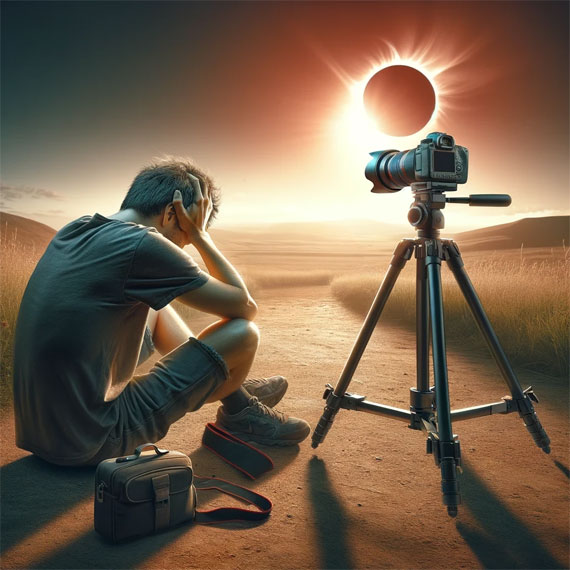Photographing a total solar eclipse is an exciting endeavor that photographers of all levels look forward to. However, due to the unique challenges it presents, many photographers, especially those attempting it for the first time, make some common mistakes. Understanding these pitfalls can help you capture this celestial event successfully. Here’s a breakdown of the most common mistakes photographers make when trying to photograph a total solar eclipse and how to avoid them:
Quick reminder: the Adventure Set has some printable cheat sheets on Eclipse Photography.
1. Not Using Proper Eye and Camera Protection
The most critical mistake is overlooking the need for proper eye and camera protection. Viewing or photographing the eclipse without a solar filter can cause irreparable harm to both your eyes and camera sensor. Always use a certified solar filter on your camera lens and wear eclipse glasses when looking at the sun.
2. Ignoring the Importance of Planning
Many photographers underestimate the importance of planning for an eclipse shoot. Researching the exact times of the eclipse phases, the weather forecast, and the location can significantly impact your experience and success. It’s essential to be in the right place at the right time with the right equipment.
3. Failing to Adjust Camera Settings
Using the wrong camera settings can result in underexposed or overexposed images. Manual mode is usually the best choice during an eclipse because it allows for quick adjustments. Remember, the lighting conditions change rapidly during an eclipse. Practice adjusting your settings in real-time and be prepared to adapt to different phases of the eclipse.
4. Neglecting to Stabilize the Camera
A sturdy tripod is a must-have for eclipse photography. The long focal lengths typically used for photographing the sun can magnify any camera movement, including the slightest shake. Ensure your tripod is stable and try to minimize contact with the camera during the shoot to avoid vibrations.
5. Overlooking the Importance of Framing
Some photographers get so caught up in the technical aspects that they forget about composition. While the eclipse itself is the star of the show, consider how you can make your image stand out. Think about including foreground elements or using the eclipse to create unique silhouettes or landscapes.
6. Not Practicing Before the Event
Given that total solar eclipses are rare events, it’s crucial to practice with your equipment beforehand. Understand how to quickly change settings without taking your eye off the viewfinder. Familiarize yourself with your camera’s controls and practice shooting in varying lighting conditions.
7. Forgetting to Experience the Moment
Finally, while photography is essential, don’t forget to experience the eclipse with your own eyes (with proper eye protection, of course). It’s a rare and awe-inspiring event that deserves to be appreciated fully, not just through your camera lens.
By being aware of these common mistakes and preparing adequately, you can increase your chances of capturing stunning images of the total solar eclipse. Remember, preparation, practice, and protection are your best tools for a successful eclipse photography experience.
For a cheat sheet you can print and take with you: Printable Eclipse Cheat Sheets
Like This Article?
Don't Miss The Next One!
Join over 100,000 photographers of all experience levels who receive our free photography tips and articles to stay current:







Leave a Reply